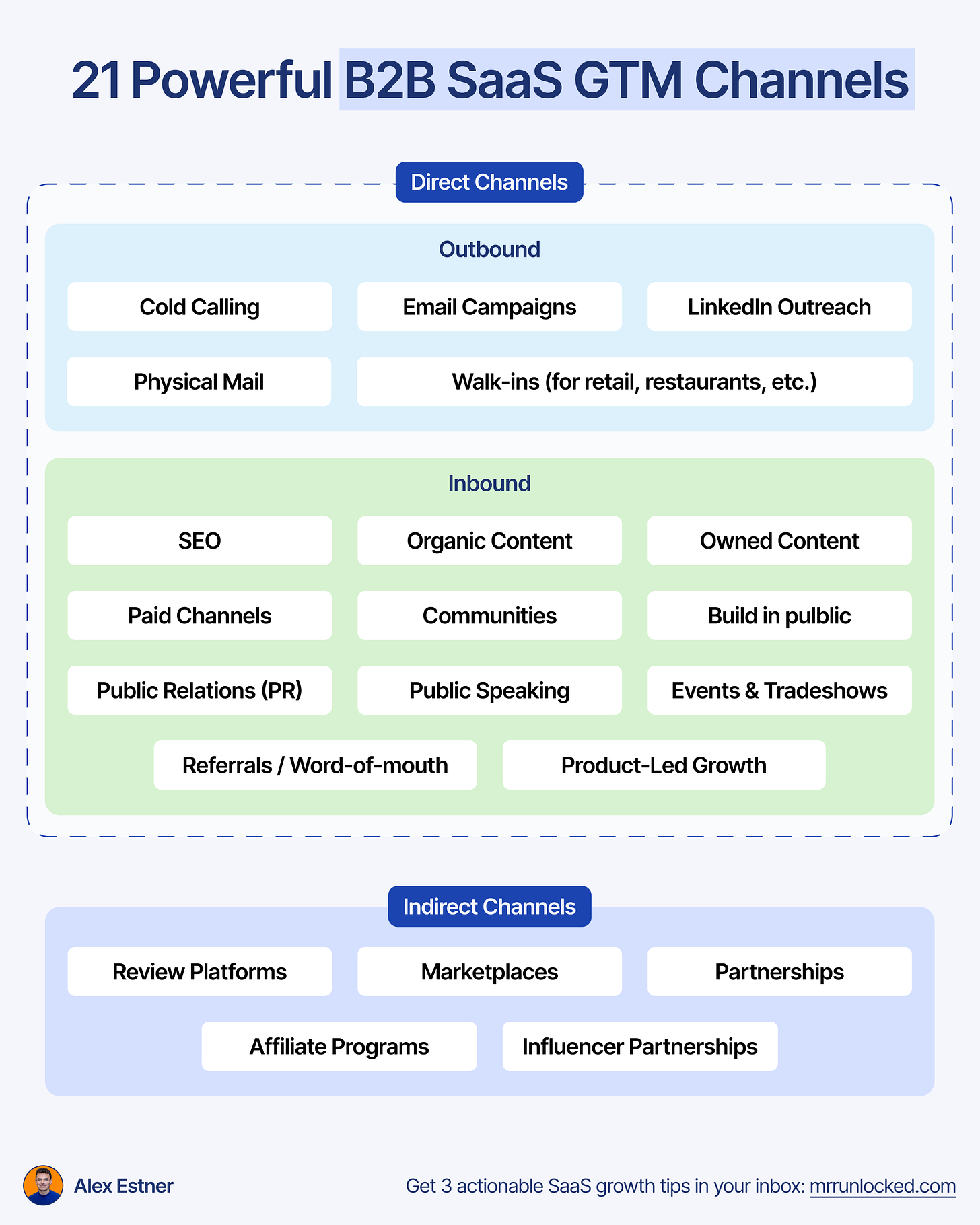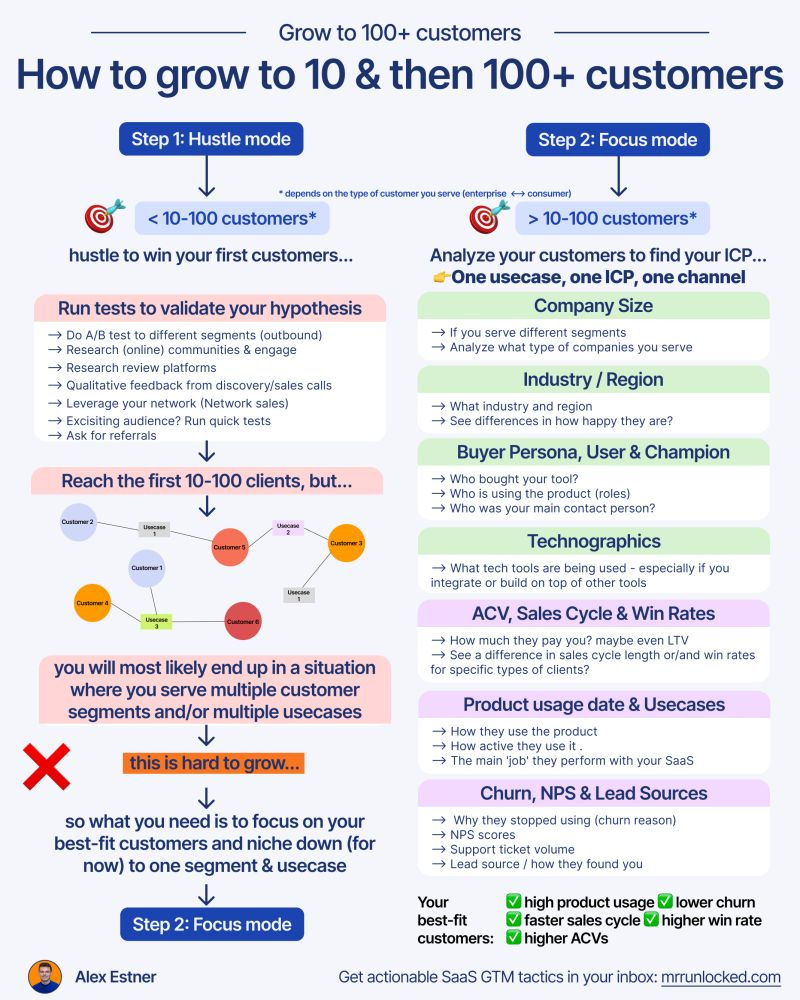Hey - it’s Alex!
Today we cover:
1️⃣ How to structure GTM channels in direct and indirect channels
2️⃣ The 21 GTM channels you can bet on for your SaaS
3️⃣ How to choose the right GTM channel(s) for your SaaS
Bonus: List of my vetted Go-to software tools for early-stage SaaS startups
In case you missed the last 3 episodes:
✅ How to create your high-converting sales deck (free template)
✅ 360° SaaS GTM Audit: 10 areas to diagnose your SaaS GTM strategy & execution
✅ The Ultimate Google Ads Guide for SaaS startups
If you’re new to the newsletter: I share bi-weekly actionable SaaS GTM strategies and tactics that will help you grow your B2B SaaS business from €0 to €1 million ARR 🚀
A quick word from our sponsors
📢 Oscr AI—Turn any content into engaging posts
Oscr AI is the Ultimate Content Creation Engine for founders & marketers. Transform research, videos, audio, and long-form articles into engaging, on-brand posts in seconds. From founders to marketers.
📢 The 7 Best GTM Guides 2024 for early-stage SaaS founders (FREE)
Growing from 0€ to 1€ million ARR is tough. Take the Christmas and New Year's break to work on your GTM foundation. To make it easier for you, I’ve compiled my best GTM Guides for you.
Want to reach 4500+ early-stage SaaS founders/leaders? Sponsor the next newsletter.
This guide aims to give you a clear overview of the channels available so you can start building a strong GTM strategy for 2025.
The different GTM Channels
A GTM Channel is a way to get your messaging in front of your ideal customer.
Some channels are better fit for initial activities to fish first clients, some are long-term GTM channels.
I like to think in hierarchies, so here is how I cluster the different GTM Channels:
1️⃣ Direct Channels
Direct channels are marketing and sales efforts directly interacting with your target customer. These can be broken into:
👉 Inbound Channels
Inbound channels attract and engage customers through valuable content and organic interest.
👉 Outbound Channels
Outbound focuses on channels where you proactively reach out to prospects to generate demand
2️⃣ Indirect Channels
Indirect channels leverage external platforms and partnerships to drive growth. It includes marketing/sales activities where third parties help you reach and sell to your customers. They usually involve some kind of ‘partnership/relationship’ with third parties.
Direct Channels
Let’s start with the channels where you are in direct touch with your ICP.
Inbound Channels
Get your message in front of your ICP on these inbound channels.
1. (Organic) Content on Social
Be present on the different social platforms. For LinkedIn keep in mind that personal profiles (e.g. founder profiles) perform better than company profiles.
LinkedIn
Twitter
TikTik, Instagram, etc.
👉 12 LinkedIn post templates to get started
2. Owned Content channels
Create content on your channels. Focus on actually sharing value for your ideal customers. This includes sub-channels like:
Your website (e.g. Blog & Resource page)
Run a YouTube channel, Podcast, and newsletter
Events & Webinars
Own Community
Free Tool (e.g. Calculator)
👉 For more on content marketing, check out the Ultimate Content Marketing Guide
3. SEO
SEO and content marketing go hand in hand, ensuring that content is optimized with relevant keywords and structured in a way that search engines and readers both appreciate.
Two disciplines within SEO that have gained popularity are Product-led SEO and Programmatic SEO.
4. Paid Channels
Paid means you are paying money to another platform (Google, Meta, etc.) to get your message in front of your ideal customers.
Paid Social
Paid Search
Sponsorships
Out-of-Home advertising
👉 Ultimate Google Ads Guide + Ultimate LinkedIn Ads Guide
5. Communities
Similar to paid channels, you use existing communities (where your ICP hangs out) to get in touch with them.
Facebook Groups (& Slack and Discord Channels)
Engage on Product Hunt, Reddit & Indiehackers
6. Build in public
It’s about openly sharing the journey of building your software, including successes, failures, and insights, to engage an audience, build trust, and create a community around the product before or during its launch.
Check out Adam Robinson, Simon Høiberg, Guillaume Moubeche to know what build-in-public means.
7. Public Relations (PR)
Building relationships with media, influencers, and bloggers to generate awareness through earned media coverage, press releases, and thought leadership.
8. Public Speaking
Depending on your product and audience, talking about your product on stage can be a great channel.
9. Events & Tradeshows
Be present at events where your ICP hangs out. Niche fairs and events can be a great lead generation channel.
10. Referral (Programs) / Word of mouth
Your current customers refer your product to others. This happens organically but can be incentivized with a proper (2-sided) referral program.
11. Product-Led Growth (Viral Loops)
It’s not a channel per se, it’s more a proper GTM motion (PLG vs. SLG). PLG leverages the product to drive user acquisition, retention, and expansion by encouraging users to naturally share or invite others (through features like referrals, user-generated content, or collaborative functionalities).
Outbound Channels
I like to divide Outbound into cold and warm outreach.
But both rely on the channels below to reach your target customers
So let’s explore the different outbound channels.
12. Cold Calling
Everyone says cold calling is dead. I don’t think so. Give it a try.
13. Email Campaigns
Email still works. You need to send relevant and personalized messages. Not generic mass emails.
14. LinkedIn Outreach
Same as Email. It works if you know who to target (your ICP), their problem, and how your solution can help them. Relevance > Personalization > Quantity.
Of course, you can combine calls, emails, and Linkedin into multi-channel campaigns.
👉 LinkedIn Prospecting Sequence Template
15. Physical Mail
Physical Emails have an awesome open rate.
By the way, Personalized letters and postcards are also a nice way to activate and retain customers (e.g. Send every new customer a personalized welcome letter).
16. Walk-ins (for retail, restaurants, etc.)
This only works if you sell to customers with offline stores (e.g. restaurants, retailers, hairdressers, sports venues…).
Warm Outreach
Warm outreach involves reaching out to prospects who have had some prior interaction with your company or show existing interest.
It’s a way to prioritize your outreach efforts.
I see 3 types of warm outreach:
1. Intent-based prospecting
Intent-based prospecting focuses on identifying target customers who have shown some level of buying intent through specific behaviors (trigger and intent signals). These signals might include website visitors, social activities, reviews, job changes, etc.
Some call this inbound-led outbound, others intent-based prospecting.
If you want to learn more about it, check out:
👉 Ultimate Outbound Sales Guide
👉 17 triggers to use for warm outreach
Besides intent-based prospecting, 2 other outreach strategies fall under ‘warm outreach’:
2. Network Sales
In network sales, you leverage your personal or professional networks (e.g., LinkedIn connections, industry events, associations) to identify and connect with potential customers. It’s one of the best ways to find your first 10 customers.
3. Referral Sales
In referral sales, you leverage existing customers, partners, or trusted connections to introduce and recommend your SaaS product to potential new prospects.
This often means reaching out to prospects through introductions made by satisfied customers, partners, or colleagues who vouch for your product and bring in trusted leads.
Cold Outreach
Cold outreach refers to reaching out to prospects who had no previous interaction with your company. The prospect may not be aware of your product and hasn’t expressed any interest in your SaaS.
Now we covered the 16 direct channels to reach your customers. Now let’s explore 5 more indirect channels.
Indirect Channels
Quick reminder: Indirect channels leverage external platforms and partnerships to engage with your potential clients.
17. Marketplaces
Marketplaces like Chrome Extensions, Salesforce AppExchange, Hubspot Ecosystem, Shopify Appstore, Zendesk Marketplace, Zapier App Directory or Zoom Marketplace.
Especially if you are building a tool ‘on top’ of an existing market leader, marketplaces can be a very powerful channel for you.
18. Review Platforms
Review sites like G2, Capterra, and OMR are great platforms for capturing existing demand. Make sure to have a strong profile and be listed in the right product category.
19. Partnerships
Under partnerships, you can find 3 main sub-categories. All leverage third parties to promote your business.
Strategic Partnerships
Collaborating with complementary software providers.
Integration marketing
Co-marketing with your integration partners.
Partner Programs
Includes referral and reseller programs.
20. Affiliate Programs
Incentivizing external promoters to drive traffic or sales.
👉 Ultimate Affiliate Program Guide
21. Influencer Partnerships
The goal is to use the influencer’s credibility and reach to promote your SaaS product. Usually, it’s based on a fixed fee + commission model.
Now you know the 21 different GTM channels available to grow your SaaS from 0€ to 1€ million ARR and beyond. However, not all channels work equally for your SaaS.
What channels are right for my SaaS?
The right GTM channel(s) for your SaaS depends on view criteria.
✅ Your ACV (annual contract value)
—> Some channels are just more expensive than others. Your pricing needs to justify the cost of the acquisitions.
✅ Stage of the company
—> Focus on direct channels first. The feedback and learnings you get interacting with your clients are super valuable. Content, Outbound, and Paid search gives you immediate feedback.
Also, some channels are very expensive (e.g. out of home) or take a long time to establish (e.g. strategic partnerships), and because of that are not available for most early-stage startups.
✅ Product Complexity
—> If your product is rather complex, buyers prefer more education and human interaction (aka. sales-led). This comes with higher ACVs and impacts your choice of the right GTM channels.
If your product is low in complexity, the opposite is true, which means SEO, affiliates, marketplaces, etc. can work quite well.
✅ Maturity of the market
—> If you are building a product in an established market, you can bet on existing demand. This means people are actively looking for solutions, so review platforms, paid search, and affiliates are channels with a good fit.
In comparison, if most of your buyers are not aware, you need to educate the market. This means you need to bet on channels that enable you to do so (e.g. outbound, owned content, events, etc.)
✅ Team/Founder Skills
—> Some call it founder-model fit. Trust on (early) GTM channels that you can master well.
That’s it for today. In an upcoming episode, I will dive into details on how to choose the right GTM model based on ACV, market maturity, product complexity, founder skills, and a few more.
Happy growth 🚀
3 ways I can help you grow your SaaS to €1 million ARR 🚀
Build your GTM strategy with my free SaaS GTM Strategy Workbook (helped 4500+ SaaS leaders)
Get access to 100+ actionable SaaS growth tactics (helped 250+ SaaS leaders) - 100% positive ROI guarantee.
Work 1-on-1 with me - GTM Advisory for early-stage SaaS founders on their way to €1 million ARR (1 free spot - limited to 8 founders).












That was a good and concise article about GTM channels. Thanks Alex.